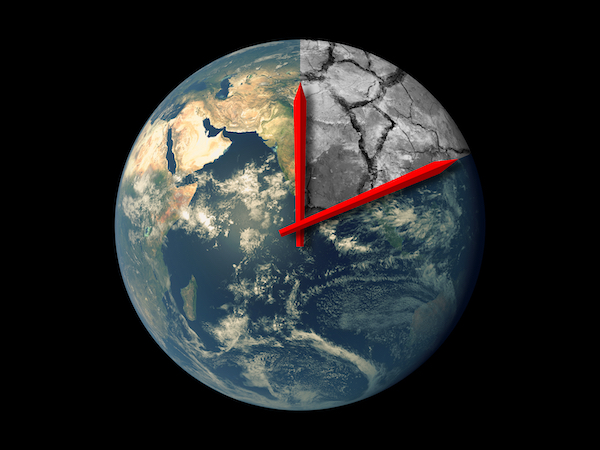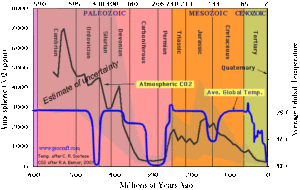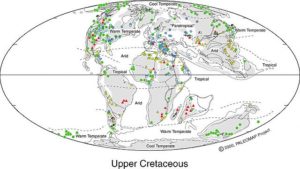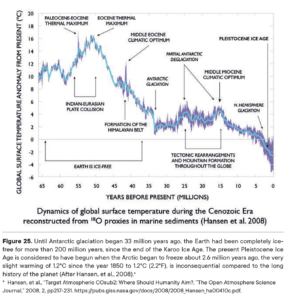
Editor’s Note: Right now, the global elite and world leaders are coming together at the UN Climate Change conference in Glasgow to address the “problem” of climate change.
Over the next couple days, Washington DC insider David Stockman will debunk the narrative and offer a comprehensive look at the climate change agenda including what it means for you.
Below is part one David’s article series…
With COP26 now underway, it’s not too soon to start clanging the alarm bells—not about climate catastrophe, of course, but about the stupidest act of the assembled nations since Versailles, when the vindictive WWI victors laid the groundwork for the catastrophes of depression, WWII, the Holocaust, Soviet tyranny, the Cold War and Washington’s destructive global hegemony, all of which followed hard upon the next.
Politicians and their allies in the mainstream media, think tanks, lobbies and Big Business (with its cowardly sleep-walking leaders) are fixing to do nothing less than destroy the prosperity of the world and send global life careening into a modern economic Dark Ages. And worse still, it’s being done in the service of a bogus climate crisis narrative that is thoroughly anti-science and wholly inconsistent with the actual climate and CO2 history of the planet.
Cutting to the chase, during the past 600 million years, the earth has rarely been as cool as at present, and almost never has it had as low CO2 concentrations as the 420 ppm level that today’s climate howlers decry.
In fact, according to the careful reconstructions of actual earth scientists who have studied ocean sediments, ice cores and the like, there have been only two periods encompassing about 75 million years (13% of that immensely long 600 million year stretch of time) where temperatures and CO2 concentrations were as low as it present. These were the Late Carboniferous/Early Permian time from 315 to 270 million years ago and the Quaternary Period, which hosted modern man 2.6 million years ago.
You might say, therefore, that the possibility of a warmer, CO2-richer environment is a case of planetary “been there, done that”. And it is most certainly not a reason to wantonly dismantle and destroy the intricate, low-cost energy system that is the root source of today’s unprecedented prosperity and human escape from poverty and want.
But that’s hardly the half of it. What actually lies smack in the center of our warmer past is a 220-million-year interval from 250 million years ago through the re-icing of Antarctica about 33 million years ago that was mainly ice-free.
As shown by the blue line in the chart below, during most of that period (highlighted in the brown panels), temperatures were up to 12C higher than at present, and Mother Earth paid no mind to the fact that she lacked polar ice caps or suitable habitats for yet un-evolved polar bears.
Global Temperature And Atmospheric CO2 Over Geologic Time

As it happened, during what has been designated as the Mesozoic Age, the planet was busy with another great task, namely, salting away the vast deposits of coal, oil and gas that power the modern economy and allow billions of people to have a living standard enjoyed only by kings just a few centuries ago.
There is no mystery as to how this serendipitous gift to present-day man happened. In a world largely bereft of ice and snow, the oceans were at vastly higher levels and flooded much of the landmass, which, in turn, was verdant with plant and animal life owing to warmer temperatures and abundant rainfall.
Stated differently, Mother Nature was harvesting massive amounts of solar energy in the form of carbon-based plant and animal life, which, over the eons of growth and decay, resulted in the build-up of vast sedimentary basins. As the tectonic plates shifted (i.e., the single continent of Pangaea broke up into its modern continental plates) and the climates oscillated, these sedimentary deposits were buried under shallow oceans and, with the passage of time, heat and pressure, were converted into the hydrocarbon deposits that dot the first 50,000 feet (at least) of the earth’s crust.
In the case of coal, the most favorable conditions for its formation occurred 360 million to 290 million years ago during the Carboniferous (“coal-bearing”) Period. However, lesser amounts continued to form in some parts of the Earth during subsequent times, in particular, the Permian (290 million to 250 million years ago) and throughout the Mesozoic Era (250 million to 66 million years ago).
Likewise, the formation of petroleum deposits began in warm shallow oceans, where dead organic matter fell to the ocean floors. These zooplankton (animals) and phytoplankton (plants) mixed with inorganic material that entered the oceans by rivers. It was these sediments on the ocean floors that then formed oil sands while buried during eons of heat and pressure. That is to say, the energy embodied in petroleum initially came from the sunlight, which had become trapped in chemical form in dead plankton.
Moreover, the science behind this isn’t a matter of academic armchair speculation for the simple reason that it has been powerfully validated in the commercial marketplace. That is, trillions of dollars have been deployed in the last century in the search for hydrocarbons, based on immensely complicated petroleum engineering research, theory and geologic models. Oil drillers weren’t throwing darts at a wildcatter’s wall but were coincidentally proving these “facts” of climate history are correct, given that they led to the discovery and extraction of several trillions of BOEs (barrels of oil equivalent).
Consequently, it is solidly estimated by industry experts that today’s petroleum deposits were roughly formed as follows:
- About 70% during the Mesozoic age (brown panels, 252 to 66 million years ago) which was marked by a tropical climate, with large amounts of plankton in the oceans;
- 20% was formed in the dryer, colder Cenozoic age (last 65 million years);
- 10% were formed in the earlier warmer Paleozoic age (541 to 252 million years ago).
Indeed, at the end of the day, petroleum engineering is rooted in climate science because it was climate itself that produced those economically valuable deposits.
And a pretty awesome science it is. After all, billions of dollars have been pushed down the wellbores in up to two miles of ocean waters and 40,000 feet below the surface in what amounts to an amazingly calibrated and targeted search for oil-bearing needles in a geologic haystack.
For instance, the Cretaceous Period from 145 million to 66 million years ago, which was especially prolific for oil formation, was a period with a relatively warm climate, resulting in high open sea levels and numerous shallow inland seas. These oceans and seas were populated with now-extinct marine reptiles, ammonites and rudists, while dinosaurs continued to dominate on land. And it is knowing this science that permits multi-billion barrel hydrocarbon needles to be found in the earth’s vasty deep.
Needless to say, the climate warmed sharply during the Cretaceous, rising by about 8 degrees C, and eventually reached a level 10 degrees C warmer than today’s on the eve of the asteroid-driven Great Extinction Event of 66 million years ago. As shown in the graph below, at that point, there were no ice caps at either pole, and Pangaea was still coming apart at the seams–so there was no circulating ocean conveyor system in the infant Atlantic.
Yet during the Cretaceous, CO2 levels actually went down while temperatures were rising sharply. That’s the very opposite of the Climate Alarmists’ core claim that it is rising CO2 concentrations which are currently forcing global temperatures higher.
Moreover, we are not talking about a marginal reduction in CO2 concentrations in the atmosphere. Levels actually dropped sharply from about 2,000 ppm to 900 ppm during that 80 million year stretch. This was all good for hydrocarbon formation and today’s endowment of nature’s stored work, but it was also something more.
To wit, it was yet another proof that planetary climate dynamics are far more complicated and ridden with crosscurrents than the simple-minded doom loops now being used to model future climate states from the current far lower temperature and CO2 levels.
As it happens, during the periods since the Great Extinction Event 66 million years ago, both vectors have steadily fallen; CO2 levels continued to drop to the 300–400 ppm of modern times, and temperatures dropped another 10 degrees Celsius.

It is surely one of the great ironies of our times that today’s fanatical crusades against fossil fuels are being carried out with not even a nod to the geologic history that contradicts the entire “warming” and CO2 concentration hysteria and made present energy consumption levels and efficiencies possible.
That is to say, the big, warm and wet one (the Mesozoic) got us here. True global warming is not the current and future folly of mankind; it is the historical enabler of present-day economic blessings. Yet, here we are on the eve of COP26, manically focused on reducing emissions to the levels required to keep global temperatures from rising more than 1.5 degrees Celsius from preindustrial levels.
Then again, exactly which pre-industrial level might that be?
We will address the more recent evolution, including the Medieval Warm Period and the Little Ice Age in Part 2, but suffice it to say that the chart below reflects broadly accepted geologic science. Still, we are hard-pressed—even with the aid of a magnifying glass—to see any time in the last 66 million years in which the global temperatures weren’t a lot higher than 1.5 degrees Celsius above current levels—even during much of the far-right margin labeled the “Pleistocene Ice Age” of the past 2.6 million years.
If your brain is not addled by the climate change narrative, the very term rings a resoundingly loud bell. That’s because there have been on the order of 20 distinct “ice ages” and interglacial warming periods during the Pleistocene, the latest of which ended about 18,000 years ago and from which we have been digging out ever since.
Of course, the climb away from retreating glaciers in Michigan, New England, northern Europe, etc. to warmer, more hospitable climes has not been continuously smooth, but rather a syncopated sequence of advances and retreats. Thus, it is believed that the world got steadily warmer until about 13,000 years ago, which progress was then interrupted by the Younger Dryas, when the climate became much drier and colder and caused the polar ice caps to re-expand and ocean levels to drop by upwards of 100 feet as more of the earth’s fixed quantity of water was reabsorbed back into the ice packs.
After about 2,000 years of retreat, however, and with no help from the humans who had repaired to cave living during the Younger Dryas, the climate system swiftly regained its warming mojo. About 8,000 years ago, during the subsequent run-up to what the science calls the Holocene Optimum, global temperatures rose by upwards of 3 degrees Celsius on average and up to 10 degrees Celsius in the higher latitudes.
And it happened quite rapidly. One peer-reviewed study showed that in parts of Greenland, temperatures rose 10°C (18°F) in a single decade. Overall, scientists believe that half of the rebound from the “ice age” conditions of the Younger Dryas may have occurred in barely 15 years. Ice sheets melted, sea levels rose, forests expanded, trees replaced grass and grass replaced desert—all with startling alacrity.
In contrast to today’s climate models, Mother Nature clearly did not go off the rails in some kind of linear doomsday loop of ever-increasing temperatures and without any hectoring from Greta, either. Actually, Greenland got all frozen up and thawed several more times thereafter.
Needless to say, the Holocene Optimum 8,000 years ago is not the “preindustrial” baseline from which the Climate Howlers are pointing their phony hockey sticks. In fact, other studies show that, even in the Arctic, it was no picnic time for the polar bears. Among 140 sites across the western Arctic, there is clear evidence for conditions that were warmer than now at 120 sites. At 16 sites for which quantitative estimates have been obtained, local temperatures were on average 1.6 °C higher during the optimum than they are today.
Say what? Isn’t that the same +1.6 degrees C above current levels that the COP26 folks are threatening to turn off the lights of prosperity to prevent?
In any event, what did happen was far more beneficent. To wit, the warmer and wetter Holocene Optimum and its aftermath gave rise to the great river civilizations 5,000 years ago, including the Yellow River in China, the Indus River in the Indian subcontinent, the Tigris-Euphrates and the Nile River civilizations among the most notable.
Stated differently, that +1.6 degrees C was reflective of the climate-based catalyzing forces that actually made today’s world possible. From the abundances of the river civilizations, there followed the long march of agriculture and the economic surpluses and abundance that enabled cities, literacy, trade and specialization, advancement of tools and technology and modern industry—the latter being the ultimate human escape from a life based on the back muscles of man and his domesticated animals alone.
At length, the quest for higher and higher industrial productivity spurred the search for ever-cheaper energy, even as intellectual, scientific and technological advances which flowed from these civilizations led to the rise of a fossil fuel-powered economy based on energy companies harvesting the condensed and stored solar BTUs captured by Mother Nature during the planet’s long warmer and wetter past.
In a word, what powers prosperity is ever more efficient “work,” such as moving a ton of freight by a mile or converting a kilogram of bauxite into alumina or cooking a month’s worth of food. Alas, during the 230 million mainly ice-free years of the Mesozoic, the planet itself accomplished one of the greatest feats of “work” ever known: Namely, the conversion of massive amounts of diffuse solar energy into the high-density BTU packages embodied in coal, oil and gas-based fuels.
As it happens, when one of the previous “preindustrial” warming eras (the Roman Warming) was coming to an end in the late 4th century AD, St. Jerome admonished the faithful “never look a gift horse in the mouth.”
Yet that’s exactly what the assembled nation’s will be doing at COP26.

Editor’s Note: We’ve seen governments institute the strictest controls on people and businesses in history. It’s been a swift elimination of individual freedoms.
But this is just the beginning…
Most people don’t realize the terrible things that could come next, including negative interest rates, the abolition of cash, and much more.
If you want to know how to survive what the central bankers and the Deep State have planned, then you need to see this newly released report from legendary investor Doug Casey and his team.
Click here to download it now.